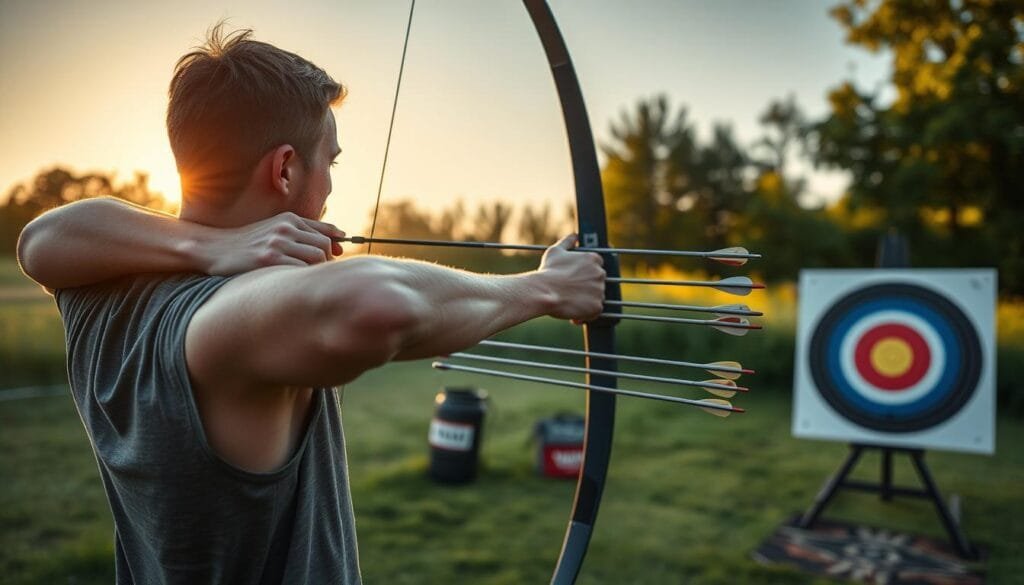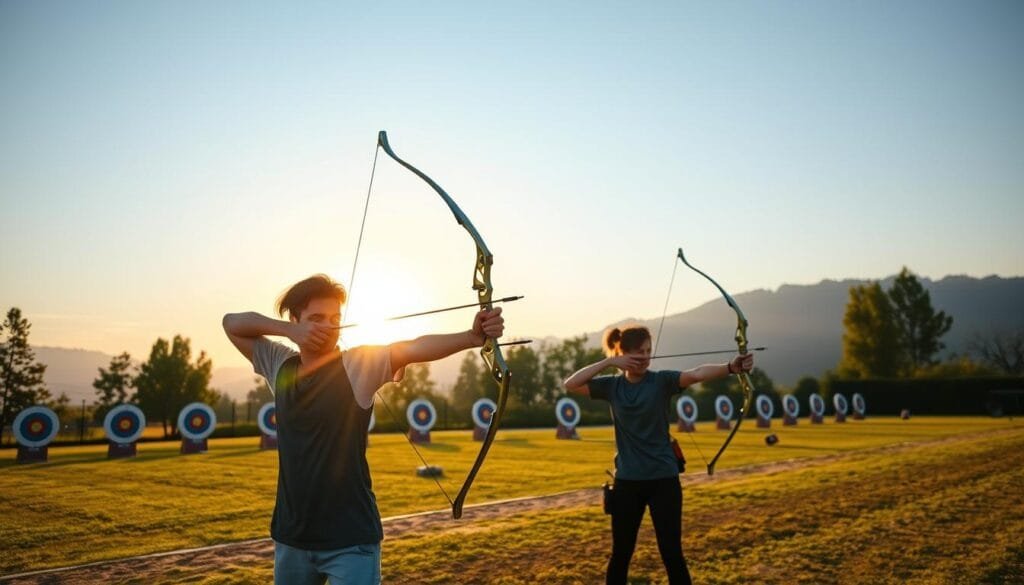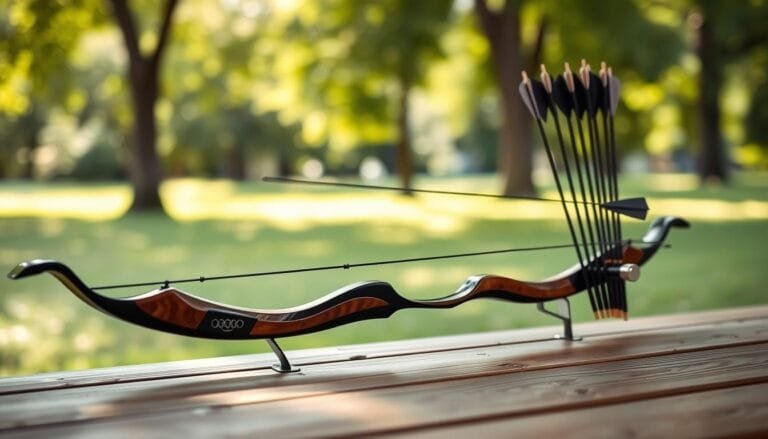Olympic Archery Bow: Essential Guide for Competition
Standing on the archery range, I feel the bow’s weight in my hands. It’s both familiar and thrilling. My heartbeat matches the bow’s gentle sway, taking me back to my first archery experience.
Table of Contents
Olympic archery demands focus, precision, and a bond between archer and bow. It’s a journey of skill and precision.
In this guide, we’ll explore Olympic archery bows. We’ll look at their key parts, specs, and accessories. Whether you’re a pro or just starting, learning about these bows will deepen your love for the sport.
Understanding Olympic Archery: History and Evolution
Archery has been around since 10,000 B.C. It started as a simple hunting tool and grew into a competitive Olympic sport. Archery first appeared at the Olympics in 1900 in Paris. But, it was removed due to different local rules.
After a 52-year break, archery returned to the Olympics in 1972. This was a big comeback for the sport.
Origins of Olympic Archery
Archery’s roots go back to ancient times. It was key for hunting and warfare. Over time, it became a fun activity and then a competitive sport.
The modern Olympic archery started in 1931. This was when the World Archery Federation (FITA) was formed. They set the rules and formats for the sport.
Modern Competition Format
Today, Olympic archery has three events: men’s, women’s, and mixed team. Archers shoot at a 122 cm target from 70 meters away. They aim for the innermost 10-point ring, which is 12.2 cm.
The competition starts with a ranking round. Then, it moves to a knockout round. In this round, archers shoot in sets of three arrows.
Key Rule Changes Through History
- The team event was introduced in 1988, adding an extra layer of strategy and teamwork to the sport.
- The mixed team event made its debut at the Tokyo 2020 Olympics, showcasing the growing prominence of gender equality in the sport.
- The scoring system has evolved from the traditional 1-10 point system to a set format, where archers compete in best-of-five sets, with each set comprising three arrows.
Archery keeps growing and remains a thrilling part of the Olympics. It tests the skills, precision, and determination of top archers.
Olympic Archery Bow Components and Specifications
In Olympic archery, the recurve bow is the top choice. It has key parts that work together for precision, power, and balance. The riser, or handle, is made from light materials like carbon fiber or aluminum. It holds the adjustable sight, stabilizers, and other important accessories.
The limbs of a recurve bow store and release energy well. They can handle a draw weight of 48-51 pounds. This lets archers shoot arrows far. The bowstring, made from strong materials like Dacron or Fast Flight, links the limbs for a smooth arrow release. Olympic arrows are made from ultra-light carbon with fletching for better stability and accuracy.
The recurve bow setup is designed for precision, balance, and power in competition. Every part, from the adjustable sight to the stabilizers, is crucial. They help archers reach their best on the world stage.
“The recurve bow is the pinnacle of archery equipment, combining cutting-edge technology with time-honored craftsmanship.”
Whether you’re an Olympic archer or new to the sport, knowing the recurve bow is key. It’s essential for mastering competitive archery.
Essential Bow Accessories for Olympic Competition
In Olympic archery, the right accessories are crucial. They help archers improve their aim and consistency. This includes everything from stabilizers to sighting tools and string parts.
Stabilization Systems
Stabilizers are vital in archery. They help balance the bow during shooting. The main stabilizer is 29 to 36 inches long. Top and bottom stabilizers add more stability, measuring 12 to 15 inches.
Sighting Equipment
Accurate aiming is key in archery. Archers use adjustable sights with a sight pin for precise shots. These tools help adjust for wind and distance, focusing the aim.
String and Arrow Rest Components
String accessories, like clickers, keep draw length consistent. They give a sound cue for the archer. The arrow rest supports the arrow, keeping it on target.
Other vital accessories include a grip for comfort and counter-balance weights for stability. Vibration dampeners reduce shock, and torque compensators minimize bow twist.
Choosing the right accessories can greatly improve an archer’s performance. This is crucial in the competitive world of archery.
| Accessory | Purpose | Typical Specifications |
|---|---|---|
| Main Stabilizer | Counteracts bow movement during the shot | 29 to 36 inches in length |
| Top/Bottom Stabilizers | Provide additional stability and control | 12 to 15 inches in length |
| Adjustable Sight | Allows for precise targeting adjustments | Sight pin for focus on the target |
| Clicker | Ensures consistent draw length | Audible cue during the draw |
| Arrow Rest | Supports the arrow during the draw and release | Maintains arrow positioning |
Proper Draw Weight and Power Requirements
In archery training for the Olympics, the bow’s draw weight is key. Men usually draw 49.5 pounds, while women draw about 40.7 pounds. The range for men is 44.5 to 54 pounds, and for women, it’s 35 to 45 pounds.
Beginners should start with a draw weight of 20 pounds or less for women and 25 pounds or less for men. This helps them learn proper archery techniques and build strength. As they get better, they should slowly increase their draw weight. They should aim to shoot at least 72 arrows comfortably during practice.
| Body Weight | Recommended Draw Weight (lbs) |
|---|---|
| Small Children (70-100 lbs) | 10-15 |
| Larger Children (100-130 lbs) | 15-25 |
| Small-frame Females (100-130 lbs) | 25-35 |
| Medium-frame Females (130-160 lbs) | 25-35 |
| Large-frame Females (160+ lbs) | 30-45 |
| Small-frame Males (120-150 lbs) | 30-45 |
| Medium-frame Males (150-180 lbs) | 40-55 |
| Large-frame Males (180+ lbs) | 45-60 |
The archery techniques and recurve bows for the Olympics are made for these draw weights. They help archers be accurate, consistent, and avoid getting tired during competitions. Archers need to train hard to build the strength and technique needed to handle these powerful bows.

“The recommendation for archers is to start shooting at a low poundage and gradually work their way up to avoid injury and ensure progress in form and technique.”
It’s important to have full control over the bow, perfect tune, and prevent injuries. This is more important than just focusing on high poundage for speed. By following the right draw weight and power, Olympic archery athletes can improve their performance and stay safe during training and competitions.
Olympic Target Setup and Scoring System
In the world of target archery, the Olympic events’ setup and scoring are designed to test the best archers. The Olympic sports arena shows the discipline and skill needed in this exciting sport.
Target Face Dimensions
The Olympic archery competitions use a 122 centimeter (48 inch) diameter target face. It has 10 scoring rings, each with a different color and point value. The yellow inner ring, 12.2 centimeters (4.8 inches) in diameter, is the 10-point bullseye archers aim for.
Scoring Zones and Point Values
- White (outer) rings: 1-2 points
- Black rings: 3-4 points
- Light blue rings: 5-6 points
- Red rings: 7-8 points
- Yellow (inner) ring: 9-10 points
Competition Distance Standards
In the Olympics, target archers compete at 70 meters (76.5 yards) for recurve events. This distance tests their strength, technique, and focus as they aim for the target’s center.
| Event | Competition Distance |
|---|---|
| Recurve | 70 meters |
| Compound | 50 meters |
| Barebow | 50 meters |
The target face is at a 75-80 degree angle, making it harder for archers to hit the center. In team events, a 1-meter line behind the shooting line allows teammates and coaches to offer support.
“The thrill of seeing an arrow strike the bullseye is unparalleled in the world of sport. It’s a testament to the dedication and skill of these remarkable Olympic athletes.”
Advanced Techniques for Olympic Bow Tuning
For Olympic archers, mastering bow tuning is key to top performance. It involves making precise adjustments to tiller and brace height. Also, fine-tuning your stabilizer setup is crucial for accuracy and consistency.
Proper limb alignment is vital in bow tuning. Studies show many tuning issues stem from misaligned limbs. Keeping limb bolt adjustments in the middle position is essential for safety and performance.
Tiller adjustments are another critical area. Most archers prefer a positive tiller for better shooting. Using multiple limb gauges helps align limbs accurately for consistent tuning.
- Properly adjust the tiller and brace height for optimal performance
- Align the limbs using multiple limb gauges for consistent results
- Fine-tune the stabilizer setup to achieve perfect balance and vibration control
String tuning is also crucial. The right brace height and twist count affect arrow flight. Archers also focus on arrow selection and tuning, matching spine to draw weight and fine-tuning fletching.
| Tuning Aspect | Recommended Range |
|---|---|
| Tiller | +0-4mm |
| Brace Height | Manufacturer Specifications |
| Nocking Point | Manufacturer Specifications |
| Centershot | Slightly Left of String |
Regular maintenance and adjustments of bow components are vital for consistent performance. By mastering these advanced archery techniques for bow tuning, Olympic archers can reach their full potential. They can deliver accurate shots, even under intense competition pressure.
Competition Equipment Regulations and Standards
Olympic archers must follow strict rules for their gear. The World Archery Federation sets these rules. This ensures everyone competes fairly.
Recurve bows must meet certain size and material standards. Arrows can’t be over 9.3 mm thick. They also need to show who shot them.
World Archery Equipment Rules
Sights are okay in Olympic archery, but no magnifying lenses. Stabilizers can be used, but only up to a certain length. All gear is checked before the competition to make sure it follows the rules.
Competition Inspection Requirements
Before each event, archers must show their gear for inspection. This check makes sure everything is up to standard. If it’s not, the archer can’t compete.
Permitted Modifications
- Personalized grips and handles
- Customized stabilizer configurations within rule limits
- Adjustments to sight settings and arrow rests
Archers can make some changes to their gear. But, these changes must follow the World Archery rules. Breaking these rules can cause penalties or even keep them out of the Olympics.
By sticking to the strict rules, Olympic archers can make sure their gear is ready for competition. This helps them do their best on the world stage.
Training and Practice Strategies for Olympic Archery
To master Olympic archery, you need a detailed training plan. It should cover physical conditioning, technical skills, and mental preparation. Aspiring archers must focus on both physical and mental aspects to succeed.
Physical Fitness is Key: Olympic archers know the value of being strong and fit. They include strength training, cardio, and flexibility in their routines. This helps them have the power and endurance needed for long competitions.
- Strength training: Pull-ups, rows, and shoulder presses build upper body strength for arrow release.
- Cardiovascular training: Running, cycling, or swimming boost endurance, keeping archers focused during competitions.
- Flexibility training: Stretching and mobility exercises ensure archers can move well for shooting.
Technical Skills Matter: Practicing regularly is crucial for archery mastery. Elite archers shoot thousands of arrows weekly to improve their technique. They use drills and simulations to refine their skills.
- Shooting volume: Practicing a lot helps archers develop muscle memory and consistent shots.
- Video analysis: Archers record themselves to analyze their form and make improvements.
- Simulated competition: Practicing under timed conditions prepares archers for Olympic events.
Mental Toughness is Essential: Archery is as much a mental challenge as it is physical. Top archers work hard on their mental skills, like focus and resilience, to perform well under pressure.
| Technique | Description | Benefits |
|---|---|---|
| Visualization | Archers mentally rehearse perfect shots and competition scenarios. | Boosts confidence and focus, helping them perform well under pressure. |
| Pre-shot Routines | Archers create consistent pre-shot rituals for focus and composure. | Improves mental and physical consistency, reducing anxiety. |
| Stress Management | Archers use deep breathing, meditation, and mental imagery to manage stress. | Helps them stay calm and make decisions in high-pressure situations. |
By combining physical, technical, and mental training, aspiring Olympic archers can develop the skills needed to excel. With hard work, discipline, and a well-rounded approach, they can aim for Olympic success.

Conclusion
Olympic archery is a captivating sport that combines precision equipment, rigorous training, and mental fortitude. Since its return to the Olympics in 1972, it has grown significantly. It showcases the best in recurve bow technology and archer skill.
Success in Olympic archery requires mastering equipment, technique, and the mental game. Athletes must constantly strive for excellence. This pushes them to new heights.
From the iconic Paris Games in 1900 to the upcoming 2024 Olympics, archery has captivated audiences worldwide. The sport’s rich history, dynamic competition format, and technological advancements make it thrilling. The world’s best archers compete for Olympic glory, inspiring the next generation.
Whether you’re an archery enthusiast or new to the sport, Olympic archery offers a thrilling experience. It showcases the precision of the recurve bow and the mental fortitude of competitors. This sport continues to captivate and inspire those who witness its displays of athleticism and skill.
FAQ
What are the typical draw weights for Olympic recurve bows?
What are the key components of an Olympic recurve bow?
What accessories are used by Olympic archers?
What are the dimensions and scoring system of the Olympic archery target?
How do Olympic archers tune and optimize their equipment?
What are the equipment regulations for Olympic archery competitions?
How do Olympic archers train and prepare for competition?
Source Links
- The Ultimate Guide to Olympic Archery
- Archery Bow Types & Types of Archery | Archery GB
- What do I need for my first recurve? – Learn about Archery
- Archery: From rules to Olympic records, all you need to know
- The History of Olympic Archery
- Olympic Archery | History & How to Qualify | Archery GB
- Anatomy of an Olympic Recurve Bow
- Recurve
- Parts of a Recurve Bow – Online Archery Academy
- Archery 101: Olympic equipment
- What Equipment Do I Need?
- What Draw Weight Should I Shoot? – Recurve Archery
- Recurve Bow Draw Weight – Chart For Choosing Drawing Weight
- How heavy is a recurve bow? The draw-weight question
- Archery 101: Olympic competition format and scoring
- Target archery
- How To Tune A Recurve Bow – The Best Guide by Olympic Experts
- Arrow tuning 102, a “next level” Olympic and barebow arrow tuning method
- Olympic Recurve Alignment
- Event Rules – USA Archery
- NFAA Shooting Styles & Equipment Rules
- How to be an Olympic archer – Bow International
- 10 training exercises that will make your archery practice more efficient
- 5 Archery Tips and Tricks to Become an Olympic Archer
- Archery in the Olympics
- The Ultimate Guide to Olympic Archery
- How far do they shoot in archery in the Olympics? Rules, records, scoring and equipment







